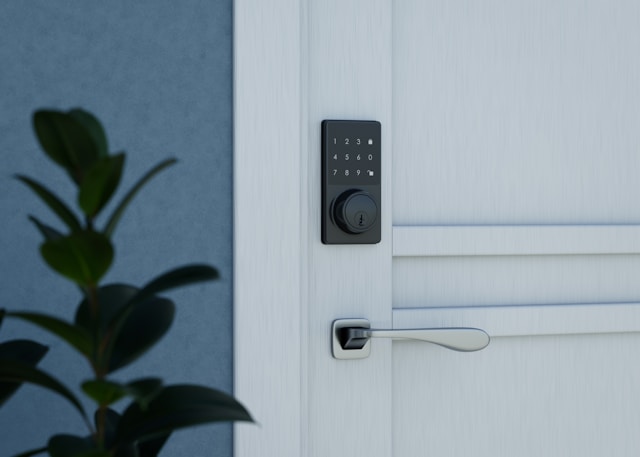Choosing the right door access solutions is key to unlocking the potential of your modern office. With advanced systems like smart automation, your workplace can stay secure without compromising ease of access. The goal is to make sure only authorized personnel can enter, keeping things safe and streamlined.
Door access solutions, from fingerprint scanners to keycard entries, are no longer exclusive to luxury buildings; they’re now a necessity in modern workspaces. These solutions not only secure your premises but also make operations more efficient. At Tech4U, we offer state-of-the-art, customizable systems that can transform your office into a secure yet welcoming environment for your team.
Evolution of Door Access Solutions
Door access solutions have come a long way over the years, evolving with new technologies and security needs. From traditional keys to cutting-edge biometrics and smart integrations, these advancements have made offices safer and more efficient.
From Keys to Keycards
In the past, offices used physical keys to manage access, but they came with issues like being easily lost or copied. Then came keycards, a more convenient and secure alternative. With keycards, businesses could better control who accessed specific areas and easily deactivate lost or stolen cards.
Keycards also introduced flexibility, allowing temporary access for guests with limited permissions. This adaptability helped modern offices become more secure and manageable.
The Rise of Biometrics
As the need for heightened security grew, biometric systems started making waves. These systems rely on unique physical traits, like fingerprints, facial recognition, or iris scans making unauthorized access much harder.
Biometrics offer a personalized level of security, ensuring only the right people can enter. Organizations investing in biometrics benefit from reduced risks of unauthorized access and an overall more secure environment.
Integration with Smart Office Technology
Today, door access systems often integrate seamlessly with other smart office technologies. This integration means that systems like lighting and climate control can adjust based on who’s in the building, offering a comprehensive and efficient way to manage office spaces.
Access Control Models Fundamentals
Access control models are key to determining who can access what within your office. These systems help streamline security and ensure efficient operation. Let’s break them down.
Discretionary Access Control (DAC)
In DAC, resource owners decide who can access specific areas. While flexible and quick to configure, DAC can pose security risks if not managed carefully. It’s important to be mindful of who has access to what and why.
Mandatory Access Control (MAC)
MAC is all about high-level security, where a central authority determines access rules. While less flexible, it offers robust protection, making it ideal for environments that require tight security, like government or military institutions.
Role-Based Access Control (RBAC)
RBAC assigns permissions based on roles within the organization. For instance, a manager might have access to more sensitive areas than a regular employee. This model strikes a balance between flexibility and security, aligning access to office resources with job responsibilities.
Key Components of Modern Office Access Systems
Modern office access systems are designed to enhance both security and convenience. Key components include control panels, electronic locks, and authentication devices.
Access Control Panels
Access control panels are the heart of your system, managing who can enter and when. They log activity, integrate with other security systems (like cameras), and can even allow remote access. As your needs grow, it’s crucial to choose a scalable, reliable control panel.
Electronic Locks and Gateways
Replacing traditional locks, electronic locks offer more flexibility. Managed through your access control system, these locks can be programmed for time-sensitive or user-specific entry. Gateways connect these locks to your network for real-time monitoring and management, making it easier to control access remotely.
Authentication Devices
Authentication devices ensure only authorized individuals can access certain areas. These could be keycards, keypads, or even biometric scanners. For high-security areas, biometric solutions like fingerprint or facial recognition scanners offer the best protection.
Ensuring these devices are compatible with your existing systems helps maximize efficiency.
Technology Trends in Door Access
Advancements in technology are making door access systems smarter and more convenient. Here’s how:
Mobile Access Credentials
With mobile access, smartphones replace physical keys or cards. This not only boosts convenience but also increases security, as your phone often requires authentication to unlock. Mobile solutions also offer remote access features, so you can easily grant or revoke access.
Cloud-Based Access Control
Cloud-based systems allow you to control access remotely, giving you the flexibility to update permissions in real-time. No need to be on-site to monitor access logs; cloud systems offer real-time insights, scalability, and enhanced data security with robust encryption.
Artificial Intelligence and Machine Learning
AI and machine learning are changing how we secure office spaces. These technologies can analyze access patterns to detect potential threats and fine-tune security measures. Over time, AI systems adapt to your office’s usage patterns, improving efficiency and minimizing false alarms.
Internet of Things (IoT) Integration
IoT devices connect and communicate across systems, offering smarter, more integrated access solutions. For example, locks and cameras can work together, automatically locking doors or triggering alarms. IoT integration optimizes both convenience and security.
Security Protocols for Access Management
Strong security protocols are essential to keeping your office safe from unauthorized access. Here’s how to protect your systems:
Data Encryption
Data encryption protects sensitive information by turning it into unreadable code, preventing unauthorized access. High-level encryption ensures that entry codes and digital keys stay secure, even if intercepted.
Multi-Factor Authentication
Multi-factor authentication (MFA) requires more than one form of verification, reducing the risk of security breaches. Even if passwords are compromised, unauthorized users still need another form of verification (like biometric data) to gain access.
Regular Software Updates
Keep your system secure by regularly updating software. These updates often include patches for security vulnerabilities, ensuring your system is protected from evolving threats.
Designing User Experience in Access Solutions
Effective door access solutions should prioritize security, ease of use, and adaptability. Here’s how to design systems that work for everyone:
User-Centric Design
A user-centric design considers the needs of everyone who interacts with the system – employees, visitors, and security personnel. Tech4U’s systems offer smartphone-controlled access, making the user experience both intuitive and convenient.
Seamless Visitor Management
Managing visitors is a breeze with self-service kiosks or mobile check-ins, reducing wait times and improving visitor experiences. Visitor data can also be tracked to enhance security and help with resource management.
Feedback and Iteration
By continuously collecting feedback, you can refine your system to better meet user needs. With our approach, your access solution remains adaptable and user-friendly, always staying ahead of technological advancements.
Regulatory Compliance and Standards
Door access systems must meet various regulations to ensure they’re safe and secure. Here’s what you need to know:
Local and International Regulations
Your door access solutions must comply with local laws and international standards (like GDPR in Europe) to ensure your system is safe and compliant.
Industry-Specific Compliance
Different industries have unique requirements, such as HIPAA for healthcare or PCI-DSS for financial institutions. Meeting these standards builds trust and ensures that your access systems are reliable.
Certification Processes
Certifications from organizations like IEC or ISO confirm your systems meet high standards. These accreditations reassure clients and partners about your commitment to security.
Sustainability in Door Access Solutions
Sustainability is key when it comes to door access systems. Here’s how to make your systems eco-friendly:
Energy-Efficient System Components
Use energy-efficient components like low-power electronic locks and motion sensors to reduce energy consumption. You can even integrate solar-powered systems to minimize your environmental impact.
Sustainable Manufacturing Practices
Prioritize manufacturers who use recycled or eco-friendly materials and focus on local production. This reduces transportation emissions and helps businesses meet sustainability goals.
Implementation Best Practices
When implementing door access solutions, follow these best practices to ensure success:
- Security First: Prioritize encryption, user authentication, and regular updates to maintain robust security.
- Maintenance: Regular checks and updates ensure your system runs smoothly.
- Integration: Ensure your access systems work seamlessly with security cameras or alarm systems.
- Training: Ensure staff understands the system to prevent errors and improve security.
- Scalability: Choose solutions that can grow with your business, saving time and money in the long run.
Future Perspectives on Office Access Technology
The future of office access is bright, with technologies like facial recognition, mobile access, and AI-driven systems on the rise. As these innovations continue to shape the industry, we can help you stay ahead with smart, secure, and efficient solutions.
Embrace the future of office access technology today and create a safer, more efficient workspace for your team.

